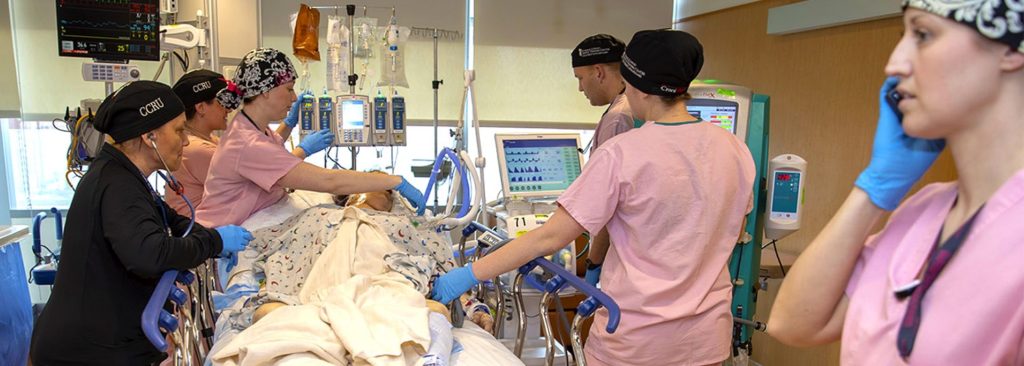Critically ill patients who experience a sudden life-threatening condition like a stroke, ruptured aneurysm, or a massive pulmonary embolism (blood clot in the lung) are often first brought to the emergency department of the closest hospital and then transferred to a larger institution if their condition is deemed to be beyond the scope of the hospital’s level of care. The process of evaluating and transferring these patients, however, is generally ad hoc and fragmented, which results in delays of patients getting time-sensitive care that could save their lives or prevent permanent disability.
To improve access to care for critically ill patients, the University of Maryland R Adams Cowley Shock Trauma Center, in conjunction with the Program in Trauma at UMSOM, established the CCRU in 2013 as the first resuscitation unit in the nation. The recent study demonstrated for the first time that utilization of the CCRU not only helped double the number of transferred patients from other hospitals’ emergency departments, but also led to faster access to critical care resources and definitive surgical treatment, which decreased a patient’s risk of dying from their illness.
“We have provided an important validation of the CCRU model, showing that it significantly improves patient outcomes,” said Quincy Tran, MD, PhD, Assistant Professor of Emergency Medicine at UMSOM who led the study. “Now that we have the data on the lifesaving potential of the CCRU, we hope to see other hospitals creating similar models.”
The study analyzed medical records from 1565 critically ill patients with 644 treated in the CCRU at the University of Maryland Medical Center (UMMC) during the first year of its operation in 2013. The rest served as control groups who were transferred directly from other hospitals’ emergency department to traditional intensive care units at UMMC during the year 2012 before the CCRU opened, and the year 2013 after the CCRU was opened
The researchers found that the average time to get into an intensive care unit after a transfer request was filed was 108 minutes for CCRU patients, compared to 158 minutes for the control group of patients who were transferred and treated in 2012 before the CCRU opened, and 185 minutes for those in 2013. CCRU patients requiring emergency surgery received that surgery about 3.5 hours on average after they arrived at UMMC compared to 6 to 7 hours after arrival for those in the control group.
After controlling for variations in the severity of disease and care, the researchers found that the CCRU patients were 36 percent more likely to survive than those in the control group, which was a statistically significant finding.
“The CCRU is modeled after the highly-effective Trauma Resuscitation Unit at the UM R Adams Cowley Shock Trauma Center. It relies on efficient communication and consultation with referring facilities and intra-hospital transport providers in order to facilitate prompt transfer of patients requiring specialized care to the University of Maryland Medical Center,” said co-author Daniel Haase, MD, Assistant Professor of Emergency Medicine at UMSOM, and Medical Director of the CCRU. “Our job is to collaborate with our specialists to deliver immediate resuscitation of patients with time-sensitive emergencies.”
Procedures performed in the CCRU include massive blood transfusions, continuous renal replacement therapy (dialysis) for patients with malfunctioning kidneys, continuous EEG monitoring of the brain, and organ support with a heart-lung machine.
“We are leading the way in critical care medicine by having the first dedicated Critical Care Resuscitation Unit in the nation,” said UMSOM Dean E. Albert Reece, MD, PhD, MBA, University Executive Vice President for Medical Affairs and the John Z. and Akiko K. Bowers Distinguished Professor. “Having the data to demonstrate improved patient outcomes will hopefully convince other hospitals to consider adopting this model of care.”
###
About the University of Maryland School of Medicine
Now in its third century, the University of Maryland School of Medicine was chartered in 1807 as the first public medical school in the United States. It continues today as one of the fastest growing, top-tier biomedical research enterprises in the world — with 45 academic departments, centers, institutes, and programs; and a faculty of more than 3,000 physicians, scientists, and allied health professionals, including members of the National Academy of Medicine and the National Academy of Sciences, and a distinguished two-time winner of the Albert E. Lasker Award in Medical Research. With an operating budget of more than $1.2 billion, the School of Medicine works closely in partnership with the University of Maryland Medical Center and Medical System to provide research-intensive, academic and clinically based care for nearly 2 million patients each year. The School of Medicine has more than $540 million in extramural funding, with most of its academic departments highly ranked among all medical schools in the nation in research funding. As one of the seven professional schools that make up the University of Maryland, Baltimore campus, the School of Medicine has a total population of nearly 9,000 faculty and staff, including 2,500 student trainees, residents, and fellows. The combined School of Medicine and Medical System (“University of Maryland Medicine”) has an annual budget of nearly $6 billion and an economic impact more than $15 billion on the state and local community. The School of Medicine faculty, which ranks as the 8th highest among public medical schools in research productivity, is an innovator in translational medicine, with 600 active patents and 24 start-up companies. The School of Medicine works locally, nationally, and globally, with research and treatment facilities in 36 countries around the world. Visit medschool.umaryland.edu
Original post https://alertarticles.info


